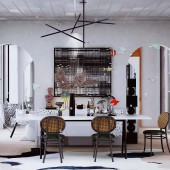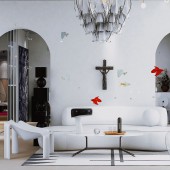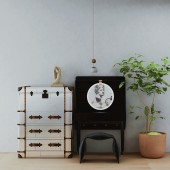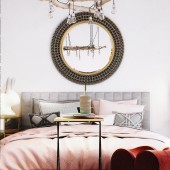
| THE AWARD |
| CATEGORIES |
| REGISTRATION |
| SUBMIT YOUR WORK |
| ENTRY INSTRUCTIONS |
| TERMS & CONDITIONS |
| PUBLICATIONS |
| DATES & FEES |
| METHODOLOGY |
| CONTACT |
| WINNERS |
| PRESS ROOM |
| GET INVOLVED |
| DESIGN PRIZE |
| DESIGN STORE |
| THE AWARD | JURY | CATEGORIES | REGISTRATION | PRESS | WINNERS | PUBLICATIONS | ENTRY INSTRUCTIONS |
Soulful Residential House by Sha Lu |
Home > Winners > Design #102936 >Interview |
 |
|
FS: What is the main principle, idea and inspiration behind your design?
SL: When I was working on this design, I suddenly thought of freedom or something deep in my heart. At that moment, a school of fish came into my mind. These schools of fish move freely in space, unrestrained, so I made a combination of what I thought at first and this free state of fish. This space looks like a kiss, so we also used some embellishments to make this space full of animacy. What we are trying to say is that in the context of global pollution and overconsumption, there is a clear, future, pure, beautiful space full of art.
FS: What has been your main focus in designing this work? Especially what did you want to achieve?
SL: It's a little bit cold, but the owners prefer the black and white look and a certain elegance that doesn't seem to follow the trend, and we used holographic projection technology to make it look more lively. It seems that there are some big and small fish schools here. At the same time as being as clean as possible, it's a bit of a fantasy. To get back to the beginning, we need to express our sense of harmony with nature. Because we all live together on this planet.
FS: What are your future plans for this award winning design?
SL: I am very happy to win this award. At the same time, this is a design with many defects. Due to the tight time, there are many things that can be improved and have not been adjusted in time, so the image presentation is still a little rough, the design itself is a simple residential design. He was ordinary, but I wanted to make him more soulful, more accessible to the people who live there, and I wanted to show that in a clean environment, we can make the space more flexible, we can use a variety of methods, as the progress of science and technology, we should be able to more convenient to do with nature and the future.
FS: How long did it take you to design this particular concept?
SL: I didn't spend a lot of time on this concept and the main thing is maybe I didn't record it in detail, because the whole process of work was done in a kind of fragmented time, so that there is no way to complete the statistics but in my impression, he should have gone through many discussions and revisions, and finally decided on the current version.
FS: Why did you design this particular concept? Was this design commissioned or did you decide to pursuit an inspiration?
SL: This concept is by the customer's request and my personal analysis of his needs, should be said to be a comprehensive product.
FS: Is your design being produced or used by another company, or do you plan to sell or lease the production rights or do you intent to produce your work yourself?
SL: My designs are usually given to clients or used for Copyright Library or Art Exchange, academic exchange, there are very few ways to sell or rent a design to someone else, and I would like to try to make my own product work for a social service that makes the product work, there are more ways to think about better presentation in the future.
FS: What made you design this particular type of work?
SL: We do many types of design, space design is one of the small categories, in fact, my design has a more personal style in it. It is not so popular, he must belong to a small group of people, right? But I am very grateful to have this group of people to identify with and communicate with you. I think that's why I am going to do the current design.
FS: Where there any other designs and/or designers that helped the influence the design of your work?
SL: For my own work, I don't ingest too much from some designers or design work, because for me the community itself is a kind of content that is not good for me personally, or the way to see better designs, or to listen to other designers share, is to capture their inner spirit and essence, which is the only thing that can make you feel fulfilled, let your imagination run wild. If you only learn from the surface, you will only learn a little. You will not be able to understand that there are too many good designs in the world, i think if I can learn to design thinking, then no matter what the change can be successfully spent, and not lost.
FS: Who is the target customer for his design?
SL: My design target customers are mainly some relatively small, love life at the same time, but also like the nature of some people like the healing style, my class is not a too large group, but I'm sure they're all warm and loving people.
FS: What sets this design apart from other similar or resembling concepts?
SL: Each design is actually different, even if we see some similar design, if they are independent of the original, then there must be some different content. If the same designer designs different works, there may be a lot of his own design styles or preferences, but every work, it must have a central idea, it must have a distinctive point, this point must be clearly presented as a central point, particularly clearly presented there as if we were talking about a theme, each design he has a theme of its own, and can not copy a theme copied to another design, the so-called template I do not exist.
FS: How did you come up with the name for this design? What does it mean?
SL: Because what I was trying to convey was a kind of inner meditation, where people think about themselves more in harmony with their environment, and they analyze it with a calm attitude, but we don't take it too seriously, we're still going to find a lot of clever stuff.
FS: Which design tools did you use when you were working on this project?
SL: We used some necessary design tools, such as drawing software, as well as some software for post-processing visual and so on.
FS: What is the most unique aspect of your design?
SL: The most unique point in my design should be to be on top of the material, on top of the commercialization, pure and clean to communicate with the most direct object.
FS: Who did you collaborate with for this design? Did you work with people with technical / specialized skills?
SL: This design mainly has my personal post-production above, the photographer also participated in the image collection and the adjustment we have our own one is mainly some creative people are engaged in with the vision related work.
FS: What is the role of technology in this particular design?
SL: Prior to the design, we had a full discussion and brainstorming with the owner to sort out all the key information and content that the other party wanted to convey, which is very helpful for the future design. And the whole thing went really well. The owner's favorite is our proposed holographic projection setup.
FS: Is your design influenced by data or analytical research in any way? What kind of research did you conduct for making this design?
SL: We'll do a data analysis of the design, and that includes a lot of things, from the customer's perspective, and from the design itself, we need to do a detailed data collection. For example, when we do a design, it's more like making a dress for a client. Not only do you need to keep a detailed record of every piece of data on him, but also to his favorite color patterns and mood and other elements of the collection this is actually a basic step, but also an essential step.
FS: What are some of the challenges you faced during the design/realization of your concept?
SL: In this design, I was mainly responsible for the soft-fitting and layout of the space, because these aspects are the areas where we are good at, so we didn't meet much challenge in general, in terms of holographic projection, we consulted the relevant staff to set up.
FS: How did you decide to submit your design to an international design competition?
SL: I got an invitation in my email, from a design a word, and I was actually kind of surprised, because I've been getting emails since last year, although I know it's probably due to some design site that has a portfolio, so he sent me an E-mail, but I didn't think to attend it before because I think my design is actually quite ordinary, it doesn't seem to be any good design, so I will attend it this year, i don't feel that my work has improved and I can take part in it, but I would like to take this opportunity to give myself a test, because I know a lot about the testing criteria in the competition, in fact, it is a good test for a designer. I want to know where I am lacking at present. I want to make efforts to correct these aspects so that I can keep learning and keep getting better, even if the process is long and slow, I'm willing to do it for the rest of my life.
FS: What did you learn or how did you improve yourself during the designing of this work?
SL: In the process of designing this work, I learned a lot about science and technology. For Space Design, communication is an important process. We need to have constant communication with customers and also with construction personnel. You learn a lot from them, it's just an exchange of knowledge. I try to write down all the interesting things I hear. They all come into play at a particular time.
FS: Any other things you would like to cover that have not been covered in these questions?
SL: Notyet。
FS: Thank you for providing us with this opportunity to interview you.
A' Design Award and Competitions grants rights to press members and bloggers to use parts of this interview. This interview is provided as it is; DesignPRWire and A' Design Award and Competitions cannot be held responsible for the answers given by participating designers.
| SOCIAL |
| + Add to Likes / Favorites | Send to My Email | Comment | View Press-Release | Translations |




